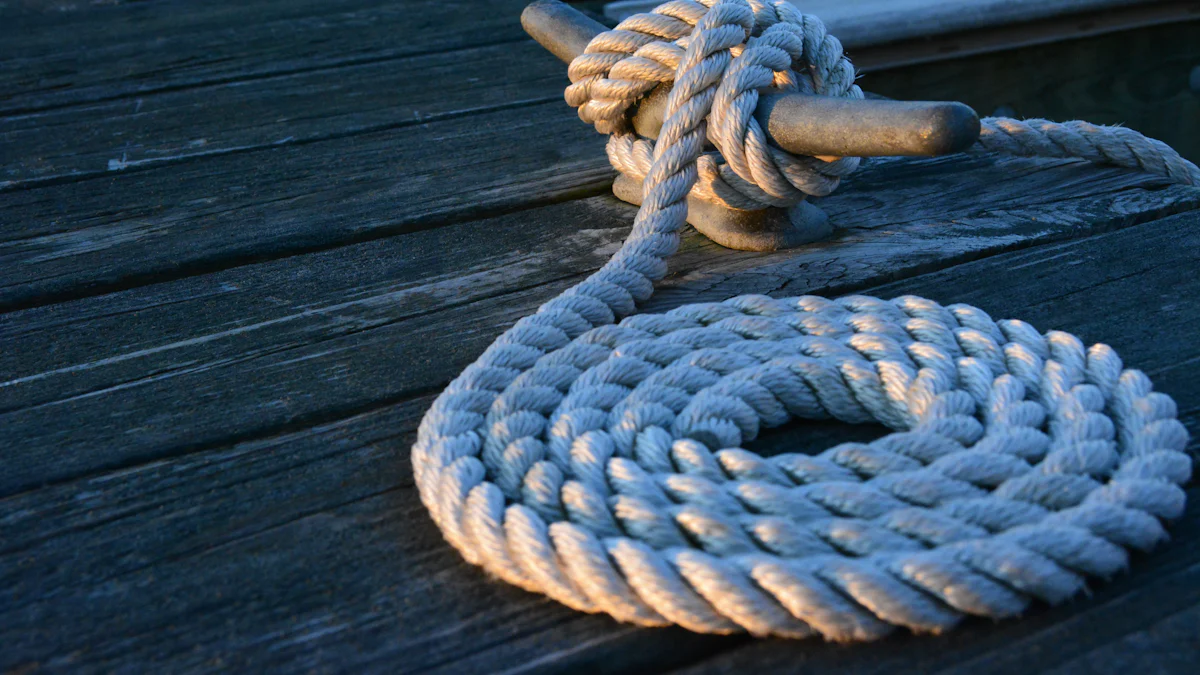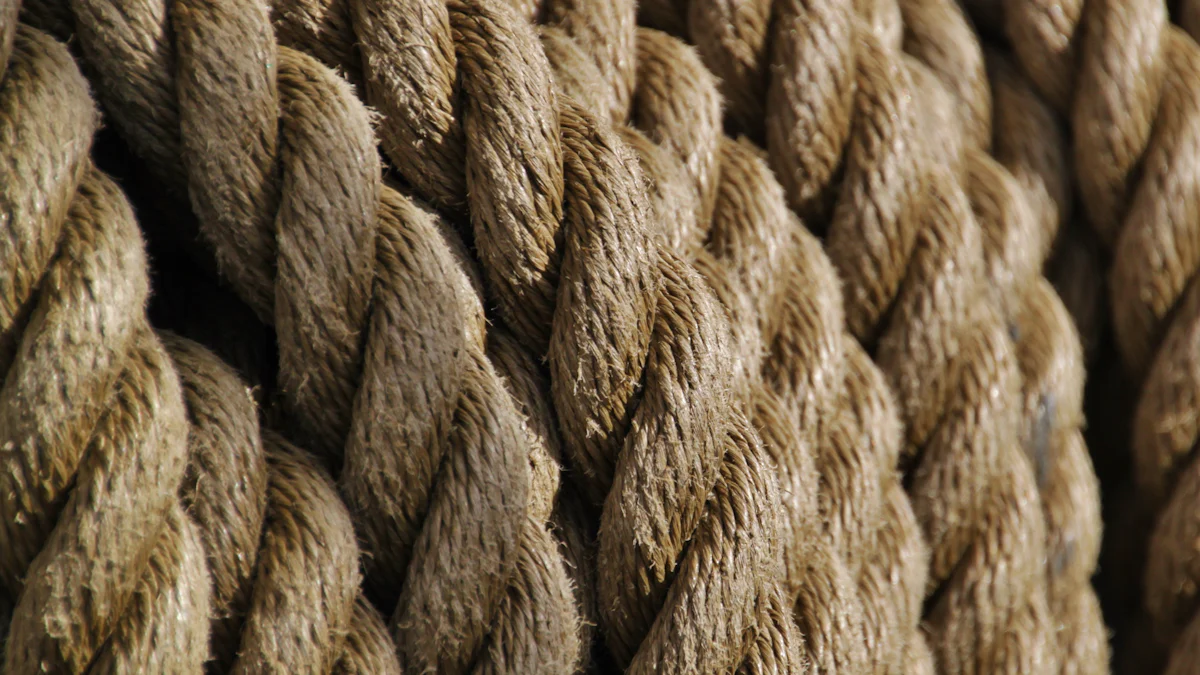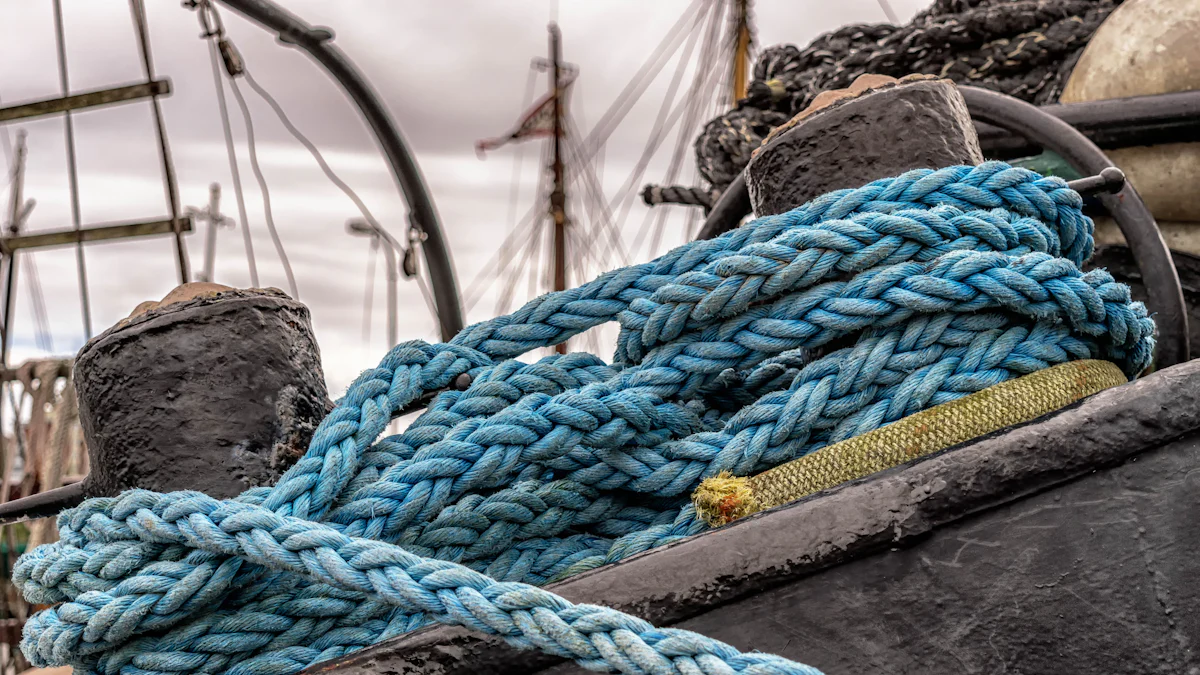How to Identify High-Quality Mooring Ropes

Selecting the right high quality mooring ropes is essential for maintaining the safety and stability of your vessel. The challenge lies in identifying high-quality mooring ropes amidst the wide array of materials and designs available.
High-quality mooring ropes provide numerous advantages, including increased durability and resistance to harsh marine conditions. Synthetic options, such as HMPE and Aramid, offer exceptional strength-to-weight ratios, making them perfect for demanding environments.
By choosing the best mooring ropes, you ensure optimal performance and longevity, protecting your investment and enhancing your maritime experience.
Understanding Mooring Ropes
Understanding the different types of mooring ropes and their applications is crucial for making informed decisions. This section will guide you through the various options available and their common uses.
Types of Mooring Ropes
Synthetic Ropes
Synthetic ropes are popular in modern maritime applications due to their strength and versatility. Polyester Mooring Ropes stand out for their durability and resistance to abrasion, UV rays, and water absorption. These ropes offer less stretch compared to nylon, making them ideal for long-term mooring. Nylon Mooring Ropes, on the other hand, provide excellent elasticity, which helps absorb shocks and reduces strain on vessels. They are commonly used onboard for their flexibility and resilience. Polypropylene Mooring Ropes are lightweight and cost-effective, suitable for short-term mooring. However, they have lower strength and elasticity, and they are prone to UV damage and water absorption, which limits their long-term use.
Natural Fiber Ropes
Natural fiber ropes, such as those made from hemp or sisal, have been used for centuries. They offer good grip and are biodegradable, making them an eco-friendly choice. However, they lack the strength and durability of synthetic options and are more susceptible to rot and mildew when exposed to moisture. As a result, natural fiber ropes are less common in modern mooring applications but may still be used for specific traditional or aesthetic purposes.
Common Uses and Applications
Recreational Boating
In recreational boating, mooring ropes play a vital role in securing vessels at docks or marinas. You might prefer synthetic ropes like polyester or nylon for their strength and ease of handling. These ropes ensure your boat remains securely moored, even in changing weather conditions. Their resistance to UV rays and water absorption makes them suitable for prolonged exposure to the elements.
Commercial Shipping
Commercial shipping demands robust and reliable mooring solutions. Synthetic ropes, particularly those made from high-modulus polyethylene (HMPE) or aramid fibers, are favored for their exceptional strength-to-weight ratios. These ropes can withstand the heavy loads and harsh conditions encountered in commercial ports. Their durability and resistance to abrasion and UV damage make them indispensable for ensuring the safety and efficiency of large vessels.
By understanding the types and applications of mooring ropes, you can select the most suitable option for your needs. Whether you're securing a small recreational boat or a massive commercial ship, choosing the right rope ensures safety and performance.
Key Characteristics of High-Quality Mooring Ropes

When selecting mooring ropes, understanding their key characteristics ensures you choose the best option for your needs. High-quality mooring ropes exhibit specific traits that enhance their performance and longevity.
Material Composition
Durability and Strength
High-quality mooring ropes must possess exceptional durability and strength. These attributes ensure the ropes can withstand the forces exerted by waves, wind, and the weight of the vessel. Synthetic materials like polyester and nylon are renowned for their robust nature. Polyester ropes offer excellent abrasion resistance and maintain their strength even when wet. Nylon ropes provide superior elasticity, which helps absorb shock loads, reducing stress on the vessel and the rope itself.
Resistance to Environmental Factors
Mooring ropes face constant exposure to harsh environmental conditions. Therefore, they must resist factors such as UV radiation, saltwater, and temperature fluctuations. Polyester ropes excel in UV resistance, making them ideal for prolonged outdoor use. Nylon ropes, while slightly less UV resistant, offer good resistance to saltwater and temperature changes. Choosing ropes with these properties ensures they remain reliable over time.
Construction and Design
Braided vs. Twisted
The construction of mooring ropes significantly impacts their performance. Braided ropes consist of interwoven strands, providing a smooth surface and increased flexibility. This design minimizes the risk of snagging and enhances handling. Twisted ropes, made by twisting fibers together, offer greater stretch and shock absorption. However, they may be more prone to unraveling under heavy loads. Your choice between braided and twisted ropes should align with your specific mooring needs.
Core and Cover Design
The core and cover design of mooring ropes also plays a crucial role in their functionality. A strong core provides the primary strength, while the cover protects against abrasion and environmental damage. Some ropes feature a double-braided design, where both the core and cover are braided, offering enhanced strength and durability. This design is particularly beneficial for high-load applications. Understanding these design elements helps you select ropes that meet your performance requirements.
By focusing on these key characteristics, you can identify high-quality mooring ropes that offer durability, strength, and resistance to environmental challenges. This knowledge empowers you to make informed decisions, ensuring your vessel remains securely moored in various conditions.
Evaluating Mooring Rope Performance
Evaluating the performance of mooring ropes is crucial for ensuring the safety and efficiency of your vessel. By understanding key performance indicators, you can make informed decisions when selecting high-quality mooring ropes.
Load Capacity and Breaking Strength
When choosing mooring ropes, you must consider their load capacity and breaking strength. These factors determine how much weight the rope can handle before it fails.
Testing Methods
To assess the load capacity and breaking strength, manufacturers use various testing methods. These tests simulate real-world conditions to ensure the ropes meet safety standards. For example, tensile testing measures the force required to break the rope. This test helps you understand the maximum load the rope can withstand. By reviewing these test results, you can select ropes that match your vessel's requirements.
Industry Standards
Industry standards provide guidelines for evaluating mooring ropes. Organizations like the International Organization for Standardization (ISO) and the Cordage Institute set these standards. They ensure that ropes meet specific safety and performance criteria. When purchasing mooring ropes, look for products that comply with these standards. This compliance guarantees that the ropes have undergone rigorous testing and meet high-quality benchmarks.
Flexibility and Handling
Flexibility and handling are essential characteristics of mooring ropes. They affect how easily you can manage and secure the ropes on your vessel.
Ease of Use
High-quality mooring ropes should offer ease of use. Flexible ropes allow for smooth handling and quick adjustments. This flexibility is particularly important when docking or mooring in challenging conditions. Polyester ropes, known for their suppleness, provide excellent handling. They remain easy to manage even after prolonged use, making them a reliable choice for many mariners.
Knot Retention
Knot retention is another critical aspect of rope performance. A rope with good knot retention holds knots securely, preventing slippage. This feature is vital for maintaining the stability of your vessel. Nylon ropes excel in this area due to their elasticity. They form tight knots that resist loosening, ensuring your vessel stays securely moored.
By evaluating these performance aspects, you can identify high-quality mooring ropes that meet your needs. Understanding load capacity, breaking strength, flexibility, and handling ensures you choose ropes that enhance the safety and performance of your vessel.
How to Choose the Right Mooring Rope for Your Needs
Selecting the right mooring rope is crucial for ensuring the safety and stability of your vessel. By understanding your specific requirements and comparing different brands, you can make an informed decision that enhances your maritime experience.
Assessing Your Specific Requirements
To choose the best mooring rope, start by evaluating your vessel's unique needs. This involves considering both the size and type of your vessel, as well as the environmental conditions it will face.
Vessel Size and Type
The size and type of your vessel play a significant role in determining the appropriate mooring rope. Larger vessels require ropes with higher load capacities to withstand the forces exerted by their weight. For smaller boats, ropes with moderate strength may suffice. Consider the material composition and construction of the rope to ensure it matches your vessel's specifications.
Environmental Conditions
Environmental factors also influence your choice of mooring rope. If your vessel operates in harsh marine environments, select ropes with high resistance to UV rays, saltwater, and temperature fluctuations. Polyester ropes are known for their excellent UV resistance, making them ideal for prolonged outdoor use. Nylon ropes offer good resistance to saltwater and temperature changes, providing reliability in various conditions.
Comparing Brands and Manufacturers
Once you've assessed your specific requirements, compare different brands and manufacturers to find the best mooring rope for your needs. Consider factors such as reputation, reviews, warranty, and support.
Reputation and Reviews
Research the reputation of various brands and read customer reviews to gauge the quality of their mooring ropes. Look for brands with a history of producing reliable and durable products. Customer testimonials can provide valuable insights into the performance and longevity of the ropes. As highlighted by Ropes Direct, investing in the correct mooring ropes not only enhances safety but also prevents unnecessary damage and expense.
Warranty and Support
A strong warranty and reliable customer support are indicators of a manufacturer's confidence in their product. Choose brands that offer comprehensive warranties, as this ensures you receive assistance if any issues arise. Good customer support can provide peace of mind, knowing that help is available when needed.
By carefully assessing your specific requirements and comparing brands, you can select mooring ropes that meet your needs and ensure the safety and performance of your vessel. This thoughtful approach protects your investment and enhances your maritime experience.
Maintenance and Care for Longevity

Proper maintenance and care of mooring ropes ensure their longevity and performance. By following a few essential practices, you can extend the life of your ropes and maintain their effectiveness.
Regular Inspection and Cleaning
Regular inspection and cleaning are vital for keeping your mooring ropes in top condition.
Identifying Wear and Tear
You should routinely inspect your mooring ropes for signs of wear and tear. Look for fraying, cuts, or abrasions on the rope's surface. These damages can weaken the rope and compromise its strength. Pay attention to areas that experience the most stress, such as where the rope contacts cleats or bollards. Early detection of wear allows you to address issues before they lead to failure.
Proper Cleaning Techniques
Cleaning your mooring ropes removes salt, dirt, and other contaminants that can degrade the material. Use fresh water to rinse the ropes thoroughly after each use, especially if they've been exposed to saltwater. For stubborn dirt, a mild soap solution can help. Avoid harsh chemicals that might damage the fibers. After cleaning, let the ropes dry completely before storing them to prevent mold and mildew growth.
Storage and Handling Tips
Proper storage and handling protect your mooring ropes from environmental damage and extend their lifespan.
Avoiding UV Damage
UV rays can weaken mooring ropes over time. To minimize UV exposure, store your ropes in a shaded area when not in use. If possible, use rope bags or covers to shield them from direct sunlight. This practice helps maintain the rope's strength and flexibility.
Proper Coiling and Storing
Coiling your mooring ropes correctly prevents kinks and tangles. Start by laying the rope flat and forming neat loops. Avoid tight coils that can cause permanent bends. Store the coiled ropes in a dry, cool place to protect them from moisture and temperature extremes. Proper storage ensures your ropes remain ready for use and reduces the risk of damage.
By implementing these maintenance and care practices, you can ensure your high-quality mooring ropes remain reliable and effective. Regular inspection, cleaning, and proper storage contribute to the longevity and performance of your ropes, safeguarding your vessel and enhancing your maritime experience.
High-quality mooring ropes are vital for the safety and stability of your vessel. By following the outlined steps, you can confidently select ropes that meet your specific needs. Consider factors like strength, elasticity, and resistance to environmental conditions. These characteristics ensure your ropes perform well under pressure and last longer. Applying these guidelines not only enhances your maritime experience but also safeguards your investment. Prioritize proper selection and maintenance to ensure your vessel remains securely moored, providing peace of mind and optimal performance.



